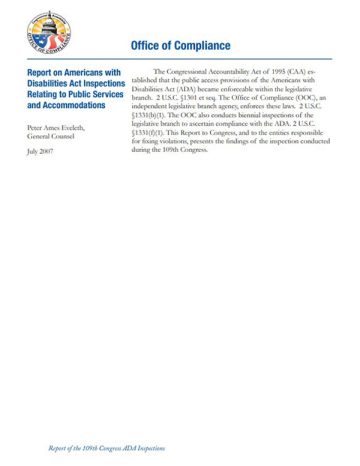Summary
Constituents and visitors to the legislative branch with disabilities are guaranteed certain rights regarding access to elected representatives, committees, staff, and to the buildings where these officials are located. Under the Americans with Disabilities Act (ADA), these rights include equal access to evacuation plans and procedures. During the 109th Congress, planning for the prompt evacuation of individuals with mobility impairments was a priority. In all public buildings on Capitol Hill, employees and visitors with mobility impairments will now be directed to designated staging areas during an emergency. From these staging areas individuals with mobility impairments will be assisted to safety by trained employees. Further, although additional work needs to be done, steady progress is being made installing visual emergency alarms in public areas and providing hallway signage giving egress information to individuals with disabilities. These changes will assure the prompt alerting and evacuation of visitors with vision and hearing impairments. The first part of this Report summarizes the findings set forth in the Individual Building Charts, attached at Appendix A. Comments from the inspected entities are attached at Appendix B.
Americans with Disabilities Act: Public Access
Public Access Provisions of the ADA Especially Relevant to Legislative Branch Entities
Title II of ADA: Access to Public Programs, Services and Activities
Title II of the ADA prohibits public entities from excluding individuals with disabilities from the “services, programs or activities” of the public entity. 42 U.S.C. §12132. See also 28 C.F.R. Part 35. These laws and regulations are applicable to each office of the Senate, each office of the House, each committee, each joint committee, the Capitol Guide Service, the Capitol Police, the Congressional Budget Office, the Office of the Architect of the Capitol, the Office of the Attending Physician and the Office of Compliance. 2 U.S.C. §1331(a). A public entity covered by Title II of the ADA must make “reasonable modifications” to practices and procedures to avoid discriminating against individuals with disabilities. Making these changes is mandatory, unless to do so would be an “undue burden” or would
fundamentally alter the nature of the program. 28 C.F.R. §35.130(b)(7); 28 C.F.R. §35.150(a)(3). A public entity need not make structural changes in the building it occupies where other modifications would allow the programs or activities to become accessible to individuals with disabilities. 28 C.F.R. §35.150(b). Thus, for example, if a Committee hearing room has a double-leafed door in which a single leaf is too narrow to allow passage of an individual in a wheelchair, the Committee must keep both doors open, or staff the doors, during all Committee hearings which are open to the public.
